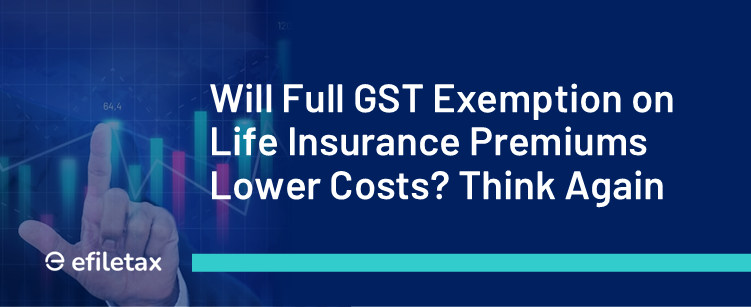
The high Goods and Services Tax (GST) rate of 18% on life insurance premiums has sparked discussions among policymakers and industry experts. Many believe that exempting life insurance premiums from GST could make these policies more affordable. However, a closer look reveals a counterintuitive outcome: a complete GST exemption may actually increase premiums. Let’s explore why.
Current GST on Life Insurance Premiums
At present, life insurance premiums are subject to an 18% GST. For instance, if your term policy premium is ₹100, you pay an additional ₹18 as GST, bringing the total to ₹118. While this seems straightforward, life insurers also benefit from an Input Tax Credit (ITC) on GST paid for services and goods used in providing insurance services.
Understanding Input Tax Credit (ITC)
ITC allows life insurance companies to offset GST paid on expenses like:
- Office rent
- Salaries and commissions for agents
- Advertising and marketing
- Operational costs like stationery and logistics
For example, if an insurer pays ₹3.6 GST on rent and ₹5.4 GST on agent commissions, they can claim an ITC of ₹9. This reduces their overall GST liability to just ₹9 (from the original ₹18 collected).
The Hidden Cost of GST Exemption
If life insurance premiums are fully exempted from GST, insurers lose the ITC benefit. This means they cannot offset GST paid on operational expenses, which now becomes a direct cost. To recover these costs, insurers may increase premiums. Here’s how it works:
- Without GST, you pay only the ₹100 premium.
- However, insurers must bear the unrecovered GST of ₹9 on operational expenses.
- To recover this, they may increase premiums to ₹109.
Thus, while you avoid the 18% GST, you end up paying a higher base premium due to the loss of ITC benefits.
Industry Demand: GST Rate Rationalisation
Life insurers advocate for a reduction in GST rates rather than a complete exemption. A reduced rate of 12% would:
- Allow insurers to continue claiming ITC.
- Keep premium costs manageable for policyholders.
- Maintain the government’s tax revenue stream.
For example, with a 12% GST rate:
- Premium = ₹100
- GST = ₹12
- Total = ₹112
This narrow margin ensures affordability without compromising the financial stability of insurers.
Case Study: ITC Analysis
A Delhi-based GST expert highlights that life insurers incur 40-45% of their ITC on GST collected from policyholders. Major expenses like agent commissions and marketing constitute 15-25% of an insurer’s costs. Removing ITC would significantly impact their profitability, forcing them to pass the cost onto consumers.
Why GST Exemption Alone Isn’t the Answer
Removing GST entirely may create short-term relief but leads to long-term challenges:
- Increased Premiums: Loss of ITC will compel insurers to hike premiums.
- Policy Sustainability: Higher premiums might discourage renewals, defeating the purpose of affordable insurance.
- Market Instability: Insurers may struggle to manage costs, affecting service quality.
The Path Forward: Striking a Balance
To ensure affordability and sustainability, the government could consider:
- Lowering GST to 12%: This ensures insurers can claim ITC while reducing the tax burden on policyholders.
- Selective Exemptions: Apply exemptions only on specific policy categories like term insurance or health insurance to target affordability where it’s needed most.
- Subsidies for Vulnerable Groups: Offer targeted subsidies for senior citizens or low-income groups to promote broader insurance coverage.
Conclusion
A full GST exemption on life insurance premiums may seem like an ideal solution, but it could backfire by increasing costs for policyholders. Rationalising GST rates and preserving the ITC system is a more balanced approach that benefits both insurers and consumers. The focus should be on creating a sustainable framework that ensures life insurance remains accessible to all.